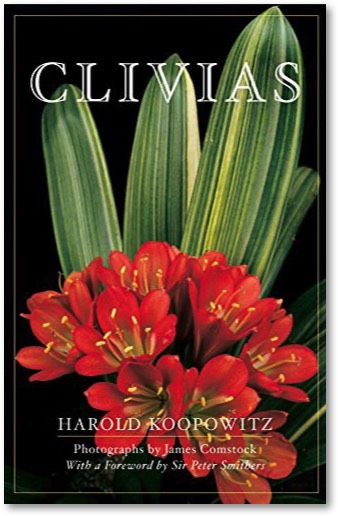
Musings » Clivias


Portland, Oregon Timber Press 2002
Professor Koopowitz at U. C. Irvine is a botanical powerhouse. Orchids are his principal specialty. He is editor-in-chief of the Orchid Digest and the author of Orchids and their Conservation. The orchid community depends on him for major technical and scientific insights into their favorite plant and yet here he is writing a superb monograph on the clivia. Moreover, he is not just an armchair expert. Koopowitz has spent a lot of time in Southern Africa, examining Clivia in the wild, counting petals and evaluating the pigments responsible for the various color tones.
In common with so many other handsome garden plants this one originated in South Africa. It was named for Lady Charlotte Florentia Clive, Duchess of Northumberland, 1787 – 1866. The name of the genus should be pronounced with a long “i”, as in the name Clive above. She was a granddaughter of the redoubtable Robert Clive, the man who consolidated English power in India so ruthlessly.
The first Clivia to be grown outside Africa was the orange C. miniata. It has upright umbels quite different from those in the other three species, C. nobilis, C. gardenii and C. caulescens. The latter have dependent umbels not unlike fritillaries.
Yellow clivias had a special mystique. They were considered to be rare and special right from the outset and cost far more than the more ordinary orange ones. Koopowitz comments that yellow is now passé and that true enthusiasts run after newer colors and forms. Even for them, a white Clivia is still something only in breeders’ dreams.
The Clivia was an instant success almost from the moment it arrived in Europe early in the nineteenth century. Almost simultaneously, specimens went to Japan where it has reigned supreme for two centuries. Clivia is a native of forests. It can even be epiphytic if a bird or animal deposits seeds in a tree fork or other perch with a modicum of plant detritus to support the development of the seed.
This forest habitat means that it tolerates fairly deep shade in our gardens. It does not mind being potbound. It has a very neat habit, doesn’t get too large and is fairly easily grown from seed. There are few plants so close to perfection.
Of course for the truly pixilated fanatic, perfection isn’t good enough. Koopowitz devotes a long chapter to hybridizing and crossings intended to develop new shapes of flower and other features. If one follows his clear directions even an amateur could create a new hybrid without too much difficulty. Clivia obsession is international. Clubs exist in Asia, Europe, North America and of course South Africa.
The plant’s arrival in California is not quite clear but in 1907, E. P. Zimmerman immigrated from Germany and settled near San Diego in Carlsbad. He seems to have and brought his collection of Clivia with him when he came. Now there are legions of enthusiasts in the state who breed the plant for many different qualities and have very specialized goals.
This book covers all the currently known varieties and offers instructions for their
culture in very straightforward terms. There is also a list of sources at the back which is most helpful. The book is a model of its kind.

